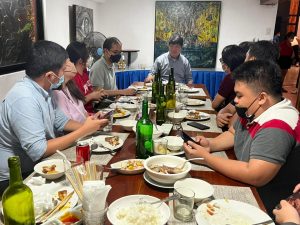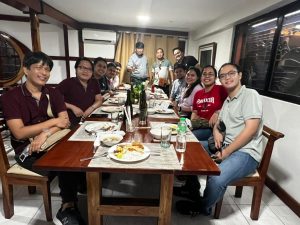‘Taste of Miagaowanon hospitality’




Livelihood in Miagao as presented by Lin-ay sang Hablon 2019
By: Rosan Frances Anselle G. Famatid
FARMING




• Farming is an ideal livelihood in Miagao having an agricultural land area of 4,983.17 hectares. This industry plays a vital role in our economy. The municipality’s main agricultural produce is rice base on the Crop Production for Calendar Year 2017. Our way of farming was once associated with manual labor and backward customary farming methods using beasts of burden (carabaos/cows) and wood-and-iron plough (arado). Through time, progress entered the farming industry “slowly but surely”. With the latest trend especially in high-value crops production such as bulb and spring onion, organic rice and vegetable, fruits, coffee and cacao, Miagao’s Farming Industry remains as the backbone of the municipality’s increasing economy.
SALT MAKING




• Salt-Making, commonly known as budbud in Miagao has been practiced for several centuries where our forefathers made clean crystalline salt directly from seawater through traditional salt-making processes utilizing solar energy to dry concentrated saltwater distributed among rows of bamboos cut lengthwise in half. This was once a vibrant cottage industry in our municipality engaged in by residents of our coastal barangays that formed part of our marketable commodity but because of the laborious production methods only a handful of communities are presently engaged in this industry. Thank you to those few remaining salt-makers, production of salt in Miagao lives and will continue living.
NATIVE DELICACIES




• Native Delicacies are essential part of the Filipino food culture, Miagao included. The delicacy can be a local food that is eaten commonly or a food that is prepared for a special occasion. Preparations for these native delicacies are painstaking but all these make them really special and worth all the work! Delicacies that are native to our municipality include rice cake (puto), baye-baye, sticky rice (kalamayhati), suman among the many lists of kakanins that would make you want to return to your town…Miagao.
FISHING




• Fishing is one of the major sources of livelihood of the people of Miagao being one of the coastal municipalities in the southern part of Iloilo. The likes of Bullet Tuna (Aloy), Yellow Fin Tuna (Bantalaan) and Blue Marlin (Malasugi) frequents our municipal waters from November to April. Local fisherfolks use traditional fishing methods such as hook and line (bunit or sibidsibidan), lift-net (vintahan), fish corral (punot) and beach seine (sahid) among others to provide foods for their family and sell to the market for additional income.
ANIMAL HUSBANDRY




• Animal husbandry refers to agricultural farming of animals that are raised for meat, fiber, milk, eggs, or other products. It includes day-to-day care, selective breeding and the raising of livestock. This industry is profitable in Miagao given the high demand for locally produced meat in the market due to its good quality and competitive pricing. The “appetite” of Miagaowanons for beef, pork chicken meat and their by-products made this industry highly viable and sustainable. Other than providing a steady source of income to farmers and backyard growers, raising pigs and other animals is interesting and a fun learning experience for them. Due to an increasing quantity of meat in the market, Miagao exports them to provide for the demands of other municipalities.
POTTERY




• Pottery is not only a great creative activity but it also a means of livelihood. Local residents of Barangay Cagbang are the living proof of how this craft was able to bring them economic prosperity. Earthenware is made from water and clay to form a masterpiece which can be used as cooking and flower pots, vases, storage vats and others. This skill was handed down through generations and the locals are keen enough to preserve this legacy for future generations to appreciate.
WEAVING




• Weaving specifically of Patadyong is an important cultural heritage of Miagao. The local weavers use wood handloom (tiral) to interlace threads to produce a masterpiece from simple combination of colors and designs to intricate ones. This weaving tradition once lost its vibrance as modernization set in and people would prefer factory-made textiles but with the municipality’s confidence in this heritage industry – combined with the locals’ wide range of ingenuity plus the boost in tourism and trade – it rebounded to regain its crown as the premier cottage industry of our town. With the massive production of Hablon, Miagao becomes one of the suppliers of this textile to renowned fashion designers.
BAMBOO CRAFT




• Bamboo are evergreen perennial flowering plants that belong to the grass family known for its versatility and many uses. Because of its strength property which is comparable to other hardwood species, it is the best substitute for wood in furniture, handicraft and even construction enterprises. In our municipality, bamboos are abundantly growing along farm, roadsides, riverbanks and even backyards. Bamboo Craft Industry in Miagao also brings food to every family’s table and able to send children to school. Our town produces products such as hat (salakot), basket (alat), grains-storage (tabungos) and the like.
COL. PEDRO ALCANTARA NACIONALES MONTECLARO
(Miagao’s Local Hero)
Pedro Alcantara Monteclaro y Nacionales was born on October 15, 1850. He was the eldest son of Captain Bartolome Monteclaro y Tupaz and Ramona Nacionales y Orbe. He had three brothers: Ciriaco, Serafin, and Jose.
Pedro received his early training and education from his parents who were devout Roman Catholics. When he was of school age, he was enrolled on the town’s parochial school run by the friars.
When he was still of tender age, he showed signs of being talented and deeply religious. In 1865 he studied at the Seminario Colegio de Jaro in Iloilo City where he obtained his Bachelors of Arts Degree.
The year 1891marked the beginning of the highly eventful life of Captain Pedro. The Spanish and town authorities saw him the qualities of a good and natural leader. He was elected Teniente Mayor in 1891 with Simeon Firmeza as Gobernadorcillo. In 1892, he became the Capitan Municipal and elected Gobernadorcillo in 1893 and reelected Gobernadorillo in 1894.
During his term of office and until the subsequent years, he was addressed respectfully as Capitan Pedro. However, he was also popularly called Tan Pedro. He is also appointed as Juez de Paz from 1895 to 1898.
His beloved wife, Isabel Manlabe, died after nineteen years of a happy married life.
in September 1898, Tan Pedro was named Comandante by the government and lead the volunteer Militia (Soldatos Voluntarios) in the town.
In December 1898, there was a conference of all revolutionary officers n Santa Barbara, Iloilo which wa presided by General Martin Delgado. Comandante Pedro and his soldiers attended the conference held at General Delgado’s Headquarters. December 16, 1898, Comandante Pedro together with his men, decided to pass by Jaro which was then under siege for days from the soldiers Colonel Quntin Salas and Colonel Agustin Solis.
Colonel Monteclaro and the rest of the Ilonggo rebel leaders fought bravely. However, by 1898, they realized the futility of struggle. Colonel Monteclaro surrendered to Major Vacher, Capt. McDonnel and Lt. Plummer. He was treated well by the Americans and was confined as a Priso Caballero. And was given privilege as a Liason Officer. His tact and influence proved successful. Peace reigned in the town when the Filipino soldiers surrendered to the Americans on the street of La Paz, now Quezon Street, on April 29, 1899.
In 1901 he was unanimously chosen by the people in Miagao as their first Municipal President from 1901 – 1903. In 1904 he finished his literary masterpiece, Ang Maragtas sang Panay.
Tan Pedro was a historian, a scholar, a soldier and a patriot, a composer of Spanish, Hiligaynon, and kinaray-a songs and poems, a good father and husband, a dedicated public servant, a born leader, and a ma of high integrity.
Tan Pedro the Legendary man of Miagao, died in grace of our Lord on April 13, 1909at age of 58. The great man died leaving behind legacy to the people of Miagao and because of him, Miagao has found its niche in the country’s history book.
Author: Lorna Monteclaro Gaton
REFERENCES:
Biografia de Pedro Alcantara Monteclaro. Files from Bienvenido Monteclaro
Pedro Monteclaro 1850-1909 by Demy P. Sonza
Brief Biographical Sketch of Pedro Alcantara Monteclaro: A Hero of Panay 1850-1909 by
Domingo Nacisvalencia and Arturo Samonte
Miagao Municipal Council Resolution No. 34, Series of 1954
Miagao Municipal Council Resolution No. 40, Series of 1974
Miagao Municipal Council Resolution No. 5, Series of 1978




